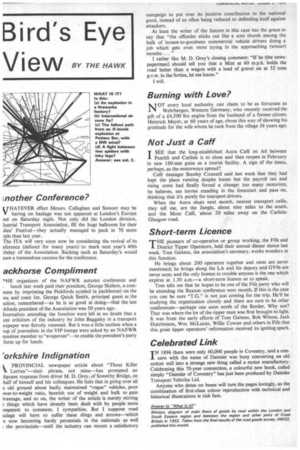Bird's Eye
Page 58

If you've noticed an error in this article please click here to report it so we can fix it.
v iew BY THE HAWK
mother Conference?
HATEVER effect Messrs. Callaghan and Stewart may be V having on haulage was not apparent at London's Europa itel on Saturday night. Not only did the London division, lustrial Transport Association, fill the huge ballroom for their dies' Festival—they actually managed to pack in 70 more Dple than last year.
The ITA will very soon now be considering the revival of its nference (defunct for many years) tomark next year's 40th thday of the Association. Backing such as Saturday's would sure a tremendous success for the conference.
ackhorse Compliment
'HE organizers of the NAFWR autumn conference and . lunch last week paid their president, George Skelton, a comment by imprinting the Pickfords symbol (a packhorse) on the mu and toast list. George Quick Smith, principal guest at the iction, remembered—as he is so good at doing—that the last :kfords president of the Association was 50 years ago.
Journalists attending the function were left in no doubt that a cut criticism of the industry by John Baggaley in a transport xspaper was fiercely resented. But it was a little tactless when a )up of journalists in the VIP lounge were asked by an NAFWR mmittee member to "evaporate" to enable the president's party form up for lunch.
'orkshire Indignation
k PROVINCIAL newspaper article about "Those Killer
Lorries"—their phrase, not mine—has prompted an Jignant response from driver M. D. Grey, of Sowerby Bridge, on half of himself and his colleagues. He feels that in going over all e old ground about badly maintained "rogue" vehicles, poor nver-to-weight ratio, boorish use of weight and bulk to gain [vantage, and so on, the writer of the article is merely stirring ) things which have already been dealt with by people more ompetent to comment. I sympathise. But I suppose road iulage will have to suffer these slings and arrows—which e now becoming hardy perennials in the nationals as well ; the provincials—until the industry can mount a satisfactory campaign to put over its positive contribution to the national good, instead of so often being reduced to defending itself against attackers.
At least the writer of the feature in this case has the grace to say that "the offender sticks out like a sore thumb among the bulk of honest-to-goodness commercial vehicle drivers doing a job which gets even more trying in the approaching (winter) months ... "
I rather like M. D. Grey's closing comment: "If he (the newspaperman) should tell you that a Mini at 60 m.p.h. holds the road better than a wagon with a load of gravel on at 32 tons g.v.w. in the forties, let me know."
I will.
Burning with Love?
NOT every local authority can claim to be as fortunate as Wehrbergen. Western Germany, who recently received the gift of a £4,500 fire engine from the husband of a former citizen. Heinrich Meyer, at 60 years of age, chose this way of showing his gratitude for the wife whom he took from the village 36 years ago.
Not Just a Caff
ISEE that the long-established Astra Café on A6 between Penrith and Carlisle is to close and then reopen in February in new 160-seat guise as a tourist facility. A sign of the times, perhaps, as the motorways spread?
Cafe manager Stanley Counsell said last week that they had kept the place running despite losses but the payroll tax and rising costs had finally forced a change: too many motorists, he believes, see lorries standing in the forecourt and pass on, thinking that it's purely for transport drivers.
When the Astra shuts next month, nearest transport cafés, they tell me, are the Jungle, about nine miles to the south, and the Moss Cafe, 'about 20 miles away on the CarlisleGlasgow road.
Short-term Licence
THE pioneers of co-operative or group working, the Fife and District Tipper Operators, held their annual dinner dance last week. Tom Gaitens, the association's secretary, works wonders at this function.
He brings about 200 operators together and rates are never mentioned; he brings along the LA and his deputy and GV9s are never seen; and the only licence to trouble anyone is the one which expires at 1.30 a.m.—a short-term licence so to speak.
Tom tells me that he hopes to be one of the Fife party who will be attending the Buxton conference next month. If this is the case you can be sure "T.G." is not just coming for the trip. He'll be studying the organization closely and there are sure to be other conferences—perhaps one soon north of the Border. Why not? That was where the lot of the tipper man was first brought to light. It was from the early efforts of Tom Gaitens, Bob Wilson, Jack Hutchinson, Wm. McLucas, Willie Cowan and others in Fife that this great tipper operators' reformation received its igniting spark.
Celebrated Link
IN 1896 there were only 60,000 people in Coventry, and a concern with the name of Daimler was busy converting an old cotton mill into a strange new thing called a motor manufactory. Celebrating this 70-year connection, a colourful new book, called simply "Daimler of Coventry" has just been produced by Daimler Transport Vehicles Ltd.
Anyone who dotes on buses -will turn the pages lovingly, as the combination of first-class colour reproduction with technical and historical illustrations is rich fare.
Answer to "What Is ltr Ministry diagram of main flows of goods by road within the London and South Eastern region and between the region and other parts of Great Britain in 1962. Taken from the final results of the road goods survey. HMSO, published this month.












































































































































